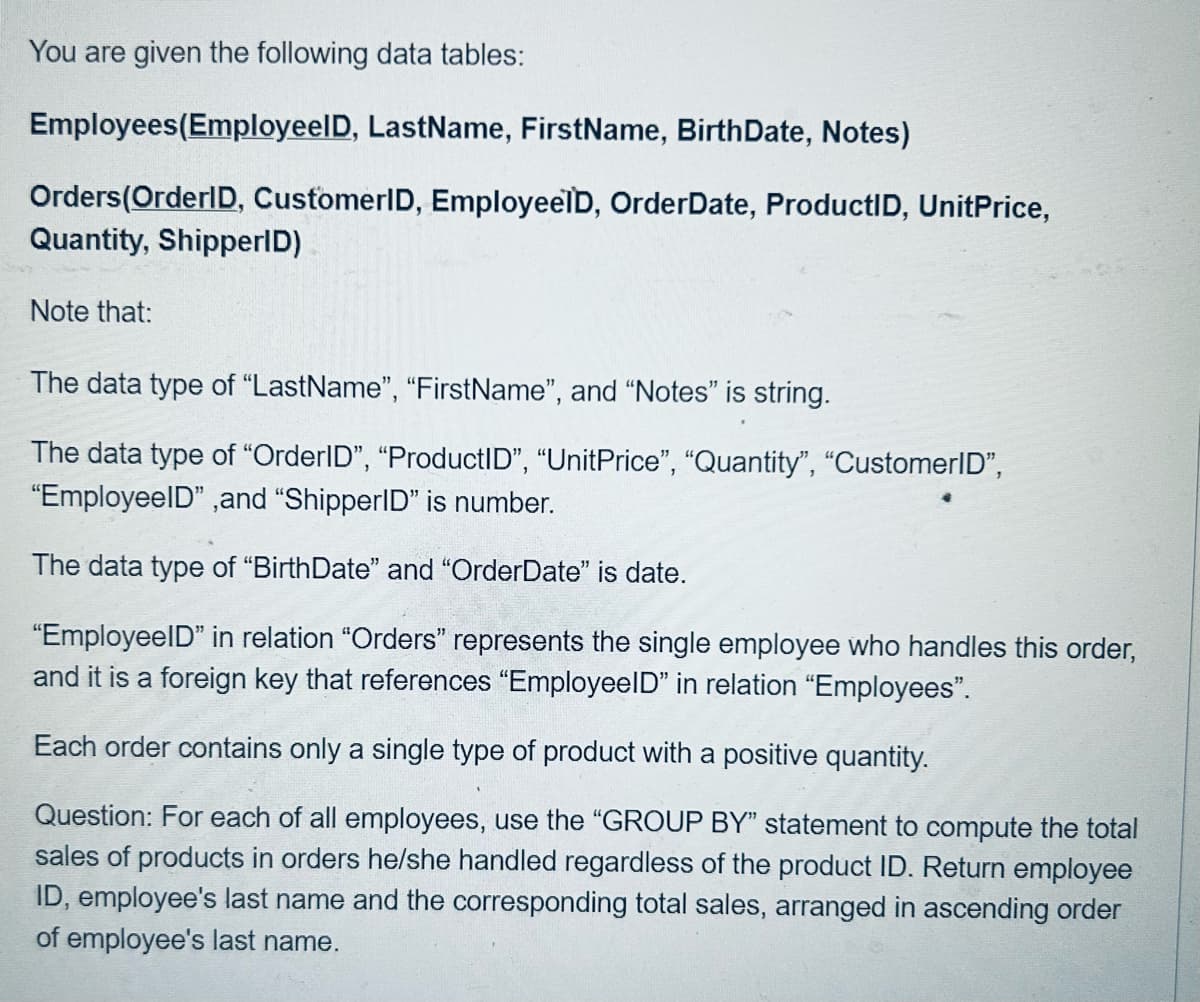Employees (EmployeelD, LastName, FirstName, BirthDate, Notes) Orders (OrderID, CustomerID, EmployeeÏD, OrderDate, ProductID, UnitPrice, Quantity, ShipperID) Note that: The data type of "LastName", "FirstName", and "Notes" is string. The data type of "OrderID", "ProductID", "UnitPrice", "Quantity", "CustomerID", "EmployeeID", and "ShipperID" is number. The data type of "BirthDate" and "OrderDate" is date. "EmployeeID" in relation "Orders" represents the single employee who handles this order, and it is a foreign key that references "EmployeeID" in relation "Employees". Each order contains only a single type of product with a positive quantity. Question: For each of all employees, use the "GROUP BY" statement to compute the total sales of products in orders he/she handled regardless of the product ID. Return employee ID, employee's last name and the corresponding total sales, arranged in ascending order of employee's last name.
Employees (EmployeelD, LastName, FirstName, BirthDate, Notes) Orders (OrderID, CustomerID, EmployeeÏD, OrderDate, ProductID, UnitPrice, Quantity, ShipperID) Note that: The data type of "LastName", "FirstName", and "Notes" is string. The data type of "OrderID", "ProductID", "UnitPrice", "Quantity", "CustomerID", "EmployeeID", and "ShipperID" is number. The data type of "BirthDate" and "OrderDate" is date. "EmployeeID" in relation "Orders" represents the single employee who handles this order, and it is a foreign key that references "EmployeeID" in relation "Employees". Each order contains only a single type of product with a positive quantity. Question: For each of all employees, use the "GROUP BY" statement to compute the total sales of products in orders he/she handled regardless of the product ID. Return employee ID, employee's last name and the corresponding total sales, arranged in ascending order of employee's last name.
Chapter11: Group Functions
Section: Chapter Questions
Problem 18MC
Related questions
Question
SQL question help

Transcribed Image Text:You are given the following data tables:
Employees(Employeel D, LastName, FirstName, BirthDate, Notes)
Orders (OrderID, CustomerID, EmployeeÏD, OrderDate, ProductID, UnitPrice,
Quantity, ShipperID)
Note that:
The data type of "LastName", "FirstName", and "Notes" is string.
The data type of "OrderID", "ProductID", "UnitPrice", "Quantity", "CustomerID",
"EmployeeID", and "ShipperID" is number.
The data type of "BirthDate" and "OrderDate" is date.
"EmployeeID" in relation "Orders" represents the single employee who handles this order,
and it is a foreign key that references "EmployeeID" in relation "Employees".
Each order contains only a single type of product with a positive quantity.
Question: For each of all employees, use the "GROUP BY" statement to compute the total
sales of products in orders he/she handled regardless of the product ID. Return employee
ID, employee's last name and the corresponding total sales, arranged in ascending order
of employee's last name.
Expert Solution
This question has been solved!
Explore an expertly crafted, step-by-step solution for a thorough understanding of key concepts.
Step by step
Solved in 3 steps

Knowledge Booster
Learn more about
Need a deep-dive on the concept behind this application? Look no further. Learn more about this topic, computer-science and related others by exploring similar questions and additional content below.Recommended textbooks for you


Np Ms Office 365/Excel 2016 I Ntermed
Computer Science
ISBN:
9781337508841
Author:
Carey
Publisher:
Cengage


Np Ms Office 365/Excel 2016 I Ntermed
Computer Science
ISBN:
9781337508841
Author:
Carey
Publisher:
Cengage